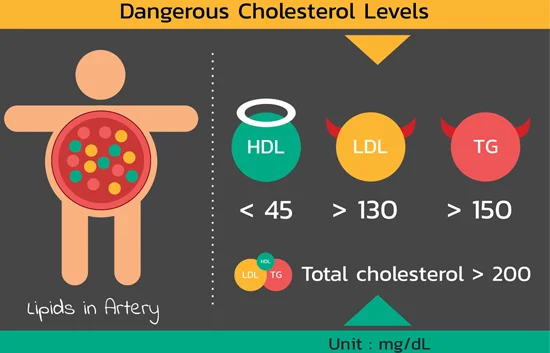Introduction to dyslipidemia: Symptoms and causes
Is dyslipidemia a heart condition?
Dyslipidemia is a very common but serious condition that should not be overlooked. It is characterized by high levels of blood lipids (cholesterol and triglycerides) that can affect normal circulation of the blood and lead to heart diseases.
How does dyslipidemia affect my heart condition?
The blood contains three main lipid types:1
- LDL (low-density lipoproteins), known as “bad cholesterol”;
- HDL (high-density lipoproteins), known as “good cholesterol”; and
- Triglycerides, the most common type of fat in your body; high triglyceride levels increase the risk of developing heart diseases.

Dyslipidemia is defined as having either high LDL levels, low HDL levels, or high triglyceride levels. Mixed dyslipidemia is one type of dyslipidemia and is characterized by elevated LDL and triglyceride levels in combination with low HDL levels.2 Many patients have mixed dyslipidemia; the risk of developing this type of dyslipidemia is higher among people with diabetes and obesity. Patients with such characteristics have a higher risk of developing cardiovascular events3 such as heart attacks and strokes. One can manage dyslipidemia under a doctor’s treatment recommendations and appropriate lifestyle changes.
Given the importance of medical guidance, it is important to discuss these issues with a doctor; he or she will recommend treatment, diet and physical exercise, all of which can have significant effects lowering the risk of certain complications.4
Symptoms

Dyslipidemia is often asymptomatic, or the symptoms are not disease-specific. Symptoms can include:5
- Chest and leg pain
- Dizziness
- Heart palpitations
- Fatigue
Given the absence of unique symptoms, it is crucial to monitor blood lipid levels, especially as one ages. Undiagnosed dyslipidemia can lead to serious problems such as heart diseases or strokes.6
Link to article 4
Causes and risk factors of dyslipidemia

Poor lifestyle choices (e.g., unhealthy eating, smoking, alcohol consumption, and lack of physical exercise) are the leading causes of dyslipidemia.3
As such, risk of dyslipidemia can be controlled by adopting positive lifestyle changes, such as eating a healthy diet, exercising, and quitting smoking. Note also that certain conditions can increase the risk of developing dyslipidemia; these include obesity and diabetes. Indeed, the more risk factors one has, the more susceptible one is to developing a cardiovascular disease. In the presence of several risk factors, it is especially important to receive medical guidance. The risks that accompany high lipid levels increase among men older than 45 years and women older than 55 years.7. Women undergoing menopause are also at higher risk of experiencing high lipid levels.8 Finally, dyslipidemia can also be inherited. For example, this is the case with familial hypercholesterolemia, an inherited disease that causes high LDL levels.9 Thus, in cases involving a family history of high cholesterol levels, it is especially important to consult a doctor and adopt a healthy lifestyle. (link article 3)
Prevention is better than cure! Getting healthy starts with a consultation with your doctor. Book an appointment with your doctor and discuss your heart health.












